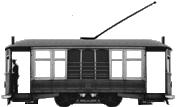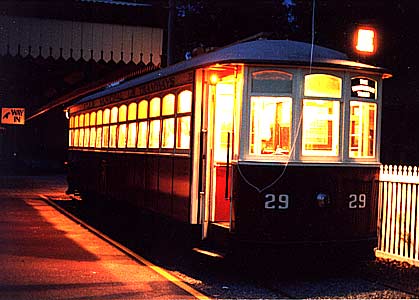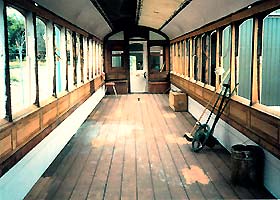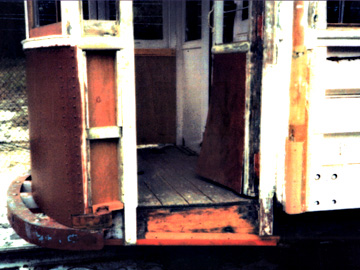Perth Electric Tramway Society
Operator of
Western Australia's Heritage Tramway
Whiteman Park - Perth - Western Australia

Restoration of Fremantle 29

Restored Fremantle tramcar 29 - the result of many years' work.
Following the closure of the Fremantle tramways in 1952, the trams were stripped of all seats and electrical and running gear, and the bodies were disposed of, mostly to be used as accommodation.
FMT 29, with two sister trams, is seen at right in its interim home - a caravan park in Albany - prior to its transfer to Perth for restoration.
Street transport preservation in Western Australia in the 1970s was centred on Castledare, where work commenced on Fremantle 29 and several other trams.
Members put a great deal of effort into body restoration over several years, but the group was hampered by lack of resources. No secure, undercover storage was available: the open storage accelerated the tram’s deterioration, and vandals were also an increasing problem. Preservation and restoration during these years became a losing battle - until the move to Whiteman Park.
Construction of the PETS complex at Whiteman Park began in January, 1982, and the body of number 29 was moved there in August, 1983. Due to the long period of open storage, much stripping down and refinishing of the body was required.


Great progress was made over the next two years, due largely to the availability of labour financed by the Australian Government’s Community Employment Project [CEP].
With the completion of the CEP scheme in 1985 the pace of restoration slowed somewhat. PETS’ financial and manpower resources had to be in large part devoted to the construction, operation and maintenance of the Whiteman Park tramway (using former Melbourne trams), funds from which would support all other museum activities.
Progress continued, however, including further work on the body. Seat components were fabricated, assembled and installed. Details in the colour scheme were refined and in some cases altered as members’ research produced new information.
The original patterned amber glass in the upper saloon and cab windows had been broken by vandals. Fortunately, Society members were able to salvage sufficient replacement glass from bodies of other Fremantle trams, found in various rural locations.
Since all mechanical and electrical equipment had been removed from the car in 1952, replacements had to be found. Some components, such as the line breaker, compressor, controllers and resistor banks, were obtained from Melbourne and extensively overhauled before installation. Braking and wiring systems were fabricated and installed by PETS members.
The narrow 3’6" gauge [1067 mm] was used in Western Australian tramways. Equipment of this size is not readily available, so the Whiteman Park Tramway has been built to standard gauge [1435 mm]. Fortunately the bodies of Western Australian tramcars are the correct width for this. The generous donation of two pairs of Brill 77E trucks by Perth’s Japanese sister city Kagoshima has meant that number 29 is equipped with running gear similar to the original.
During 1991 and 1992, concentrated attention could again be given to restoration, and the rate of progress accelerated. After an intensive effort by PETS members, Fremantle 29 became, in May, 1992, the first Western Australian tramcar to move under its own power for some 33 years — almost 40 years after it was scrapped.